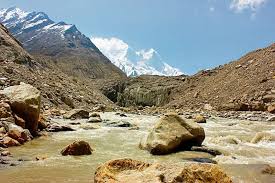NEW DELHI: Melting of glaciers in Uttarakhand could lead to apocalyptic consequences, including scarcity of water in the region.
Experts at the Wadia Institute of Himalayan Geology, Dehradun, claim that all 900 glaciers located in Uttarakhand are melting due to global warming. Some of the important glaciers that are melting at a fast pace are Gangotri, Satopanth, Bhagirathi and Raikhana. Dr Manish Mehta of the institute said, “Glacier melting is a natural process. However, the speed at which they are melting is worrying. Of the 9,575 glaciers in the Himalayan region, 900 are in Uttarakhand, and all are melting owing to the global warming.”
He said greenhouse gas emissions increase the temperatures, which accelerates the melting process.
According to a study of the Intergovernmental Panel on Climate Change, the melting process could speed up the movement of water from mountains to rivers. However, as glaciers shrink in response to a warmer climate, there will be a turning point after several years when its contribution to river flow downstream will decline.
Explaining the ramifications, Mehta said, “There could be water scarcity in the region due to the melting of the glaciers. This will also impact electricity generation. Notably, the nutrient supply to the Gangetic plains will also decrease. Also, aquatic species in rivers will eventually become extinct.”
While it was not possible to completely stop the melting process, adoption of mitigation measures would slow it down, he said.
“Afforestation can slow the melting process. Green areas around the glaciers should be maintained and forests should be protected,” Mehta said.
An official from the Department of Science and Technology confirmed that it had funded research and development projects to study different aspects of glaciers.
“The Divecha Centre for Climate Change at the Indian Institute of Science, Bengaluru, is mapping existing and potential glacial lakes, identifying numerous sites in Sikkim and Uttarakhand that could potentially cause flashfloods in the region. Studies by the Wadia Institute of Himalayan Geology have reported an increase in hazards related to shrinking glaciers,” he said.
An increase in the deposit of black carbon in the Himalayas is also stated to be a contributing factor in faster melting of glaciers.
Black carbon is the sooty black material emitted from gas and diesel engines, coal-fired power plants, and other sources that burn fossil fuel.
In an action taken report tabled in the Lok Sabha, the Parliamentary Standing Committee on Water Resources said though black carbon was a major reason behind the melting of glaciers, the Union Government had neither conducted any research on the estimated loss of glaciers in the Himalayan region nor projected its loss in the nearby future.


